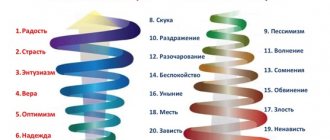Emotions control a person more than it seems at first glance. Even the absence of emotions is an emotion, or rather a whole state, which is characterized by its own characteristics in human behavior.
Emotional states are mental states that arise in the process of a subject’s life and determine not only the level of information and energy exchange, but also the direction of behavior.
Why is it so important to recognize your emotional state and that of others? It’s simple: the direction of thoughts, thinking capabilities, behavior, level of aggression, motivation, and sociability depend on it.
If you don't understand your emotional state, you won't be able to influence it if it becomes destructive. You will probably try to drown it out with external solutions such as alcohol, cigarettes, shopping or food - but all this will ultimately not help and will affect both your health and psyche.
If you do not know how to recognize the emotional state of your interlocutor, this can lead to conflicts. This has happened to everyone: you seem to be talking to a person as usual, but you are greeted with aggression. Therefore, we will divide the article into two parts. In the first, you will receive tips on how to recognize your own emotional state, and in the other, how to understand someone else’s.
General characteristics of methods for assessing emotional states
As a rule, methods for studying emotional reactions are:
- Observation
- Questionnaire
- Questioning
- Game methods (for children)
- Art therapy methods (suitable for both children and adults. Art therapy is a unique and fairly simple technique. In addition, its results are quite accurate. The principle of its action is projection, that is, in fact, subjects can unconsciously depict this or that problem, which a specialist will help decipher).
An instant test that will determine your real emotional state
An instant test that will determine your real emotional state. Today, there are many techniques that experienced recruiters and managers use to determine the personality type of their employees and establish effective communication links. Just a few decades ago, they were complex and time-consuming, but they made it possible to gain a good understanding of a person’s character.
the Luscher test turned out to be interesting, fast and accurate , and it can be used outside the office. The first one is color. It gives an idea of what a person is gravitating towards at the moment, depending on his mood and well-being. The second involves analyzing the current psycho-emotional state based on the choice of objects of one form or another and identifying key character traits.
So, we suggest you choose one of these delicious cookies. Please note: look at the illustration for no longer than 10 seconds. After this, you can proceed to interpreting the results.
An instant test that will determine your real emotional state.
Round and brown
The circle is usually chosen by sociable and peace-loving people. They gladly take part in resolving the personal conflicts of others and are ready to do anything to make everyone around them happy. They also often cross the line between public and private interests, although they do this not out of malice. Brown color shows a person's positive perception of his own physical condition. That is, the person who chooses these cookies feels quite good and is not distracted by health problems.
Assessment of emotional expressions includes three levels:
- adaptive-mobilizing (detection of changes in state parameters at the physiological level),
- behavioral-expressive (tracking external expressions of states in facial expressions, behavior, voice),
- subjective-evaluative (the subject orally or in writing expresses a subjective assessment of his experiences based on his own perception and analysis).
Diagnosis of emotional manifestations usually occurs in three directions:
- The study of conscious components of the emotional state, expressed in subjective experiences.
- The study of expressive components of the state, manifested in behavior, speech, pantomime, and products of activity.
- Study of unconscious manifestations reflected in vegetative changes in the body.
Esoteric test for the internal state of the soul from Vitaly Gibert
Vitaly Gibert, a participant in the “Battle of Psychics,” invited users of his website to take a unique test to determine a person’s internal state. With its help, you can look at yourself from the outside and decide what needs to be changed in your life to achieve happiness.
Test from psychic Vitaly Gibert
For this esoteric test, you do not need to answer questions and then calculate your points. You just need to take a piece of paper with a pen and draw a house in which you would like to live.
Once your drawing is ready, all you have to do is find out the results.
Multi-storey building - now you are in your own world, where you don’t want to let anyone in. To the people around you, you seem like a closed and callous person. Now you are focused on your problems that are gnawing at you and giving you no rest. Advice from psychic Vitaly Gibert: open up to the world, don’t be afraid to be misunderstood, share your worries and experiences with loved ones.
Small low house - you are tired of what is happening around you. Now you are happy to return to your past, since only memories fuel you with energy. Advice from Vitaly Gibert : do not feel sorry for yourself and do not isolate yourself. Live in the present and look for the positives in every day you live. Take responsibility for your actions and words and do not blame anyone for your failures.
Castle - you are in a state of flight. You are a dreamer and sometimes your imagination is limitless. You are burdened by a situation that forces you to make decisions and bear responsibility. Advice from Vitaly Gibert: don’t take off your rose-colored glasses if you want to. Just try to make your dreams and ideas come true. In the real world they will bring you much more benefit than in the imaginary world.
Hut - you need family support. Sometimes you feel lonely and want to get rid of it. Advice from Vitaly Gibert: take the first step in reconciliation and establishing contacts with loved ones, tell them openly about your feelings and they will reciprocate your feelings.
Fence. The higher the fence in your drawing, the more you strive to isolate yourself from the outside world.
Window. If you drew one large window, then this speaks of spiritual kindness and openness. If there are many windows and they are small, then this indicates greed, secrecy and selfishness.
Doors. An open door is a sign of sociability and kindness. A closed door speaks of a reluctance to communicate and let people into your world. If the door is at the front of the house, you are confident and not afraid of change. A door on the side is a sign of isolation and pessimism.
The trumpet is a sign of optimism and kindness. If there is no pipe in the picture, it means that your world is built on grievances, suffering and disappointments.
Appreciate every day of your life, do good and don’t be afraid of change. We hope that this test from Vitaly Gibert helped you understand yourself more.
Your psychologist. The work of a psychologist at school.
The “Self-Assessment of Emotional States” technique is a questionnaire developed by American psychologists A. Wessman and D. Ricks and intended for self-assessment of a person’s well-being and emotional state at the time of examination [Big Encyclopedia of Psychological Tests / comp. A. Karelin. – M.: Eksmo Publishing House, 2006. – 416 p.]. The questionnaire consists of four blocks of statements (scales). Each scale includes 10 statements. The scale statements are arranged in descending order, from the pole of a positive emotional state (10 points) to the pole of a negative emotional state (1 point). The subject is asked to rate his emotional state by selecting the appropriate statement. The serial number of the statement corresponds to the number of points scored on the scale. Questionnaire scales: “Calmness - anxiety”, “Energy - fatigue”, “Elation - depression”, “Feeling of self-confidence - feeling of helplessness”. There are no significant data on the procedure for developing and standardizing the methodology.Instructions: Choose from each of the proposed sets of judgments the one that best describes your state now. Circle the number of the judgment selected from each set. List of statements by scale:
I. “Calmness - anxiety” 10. Perfect and complete calmness. Unshakably confident in himself. 9. Extremely calm, extremely confident and not worried. 8. Feeling of complete well-being. I am confident and at ease. 7. Generally confident and free from anxiety. 6. Nothing particularly bothers me. I feel more or less at ease. 5. Somewhat preoccupied, feeling constrained, a little anxious. 4. I am experiencing some concern, fear, anxiety or uncertainty. Nervous, worried, irritated. 3. Significant uncertainty. Quite traumatized by uncertainty. Scary. 2. Tremendous anxiety and concern. Plagued by fear. 1. Completely mad with fear. Lost my mind. Frightened by insoluble difficulties.
II. “Energy - fatigue”10. An impulse that knows no barriers. Life force overflows. 9. Overflowing vitality, enormous energy, a strong desire for activity. 8. Lots of energy, strong need for action. 7. I feel very fresh and have a lot of energy left. 6. I feel quite fresh, moderately cheerful. 5. Slightly tired. Laziness. There is not enough energy. 4. Quite tired. Apathetic (sleepy). There is not much energy left. 3. Great fatigue. Lethargic. Scarce energy resources. 2. Terribly tired. Almost exhausted and practically incapable of action. There are almost no energy reserves left. 1. Absolutely exhausted. Incapable of even the slightest effort.
III. “Elation - depression” 10. Strong enthusiasm, enthusiastic joy. 9. Very excited and in a very high state. Enthusiasm. 8. Excited, in a good mood. 7. I feel very good. Cheerful. 6. I feel pretty good, okay. 5. I feel a little depressed, so-so. 4. The mood is depressed and somewhat sad. 3. Depressed and feeling very depressed. The mood is definitely gloomy. 2. Very depressed. I feel absolutely terrible. 1. Extreme depression and despondency. Depressed. Everything is black and gray.
IV. “A feeling of self-confidence is a feeling of helplessness” 10. Nothing is impossible for me. I can do whatever I want. 9. I feel more confident in myself. Confident in my achievements. 8. Very confident in your abilities. 7. I feel that my abilities are sufficient and my prospects are good. 6. I feel quite competent. 5. I feel that my skills and abilities are somewhat limited. 4. Feeling pretty incapable. 3. Depressed by his weakness and lack of abilities. 2. I feel pathetic and unhappy. Tired of my incompetence. 1. A pressing feeling of weakness and futility of efforts. I can't do anything.
Processing and interpretation of results Measurement in the method is carried out using a 10-point (wall) system. In general, the higher the selected score, the closer the subject's condition is to the positive pole of each scale (and vice versa). The following indicators are measured: P1 (indicator) - C (self-esteem) “Calmness - anxiety” (individual self-esteem - I1 - equals the number of the judgment selected by the subject from this scale. Individual values for indicators P2, P3, P4 are obtained in the same way); P2 - C “Energy - fatigue”; P3 - C “Elation - depression”; P4 - C “Feeling of self-confidence - feeling of helplessness”; P5 - C - total state assessment on four scales: I5 = I1 + I2 + I3 + I4, where I1, I2, I3, I4 are individual values on the corresponding scales.
Introduction
The relevance of the work may be due to the fact that recently people have become less likely to show their emotions, replacing them with emoticons on social networks. An analysis of more than 31 million messages on Twitter showed that emoticons are a common component of text. An experiment was also conducted in which participants had to communicate online. It was found that subjects considered experts who used emoticons when communicating to be more friendly and competent. In connection with the above, the relevance of the topic is beyond doubt.
The object of the course work was emotional states.
The subject of study is methods for diagnosing emotional states.
The purpose of the course work is to compare methods for studying emotional states.
The hypothesis of the study is that the relevance of emotional states is presumably associated with recognizing the emotions of other people.
Based on the object, subject, hypothesis and purpose of the course work, the following tasks were set:
1. Explore the theoretical foundations of the study of emotional states.
2. Analyze psychological methods for diagnosing emotional states.
The theoretical basis of the study is the scientific ideas and theoretical positions of such authors as Wilhelm Wundt, William James, John Watson, Carroll Izard, Sergei Leonidovich Rubinstein, Pyotr Kuzmich Anokhin, Pavel Vasilievich Simonov, Alexey Nikolaevich Leontiev, Paul Ekman, Izard Carroll.
Methods for studying emotional states: “Ekman Faces” test, “Differential Emotions Scale” technique, Spearman rank correlations, comparison, analysis, synthesis, generalization.
The practical significance of the research may lie in the fact that the information I received can be used by practicing psychologists in their scientific practice.
Is it dangerous to ignore your emotional profile?
If you work in a field that does not meet the needs of your emotional background, and are also limited in resources to satisfy them outside the profession, this can have a bad effect on the psyche as a whole. Dissatisfaction tends to accumulate like a snowball. Little things that you didn’t notice yesterday will begin to irritate and irritate you the day after tomorrow.
Limiting your activity to daily routine and household responsibilities can lead to depression and cause other mental disorders. This will affect the quality of communication with loved ones, colleagues, and the worldview in general. We recommend that you listen to the test results and take time for pleasant moments.









